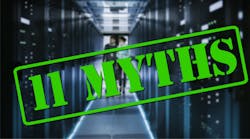1. Standard SMART is good enough.
Typical SMART (Self-Monitoring, Analysis and Reporting Technology) implementations don’t provide sufficient visibility into solid-state drive usage, data patterns, or even data retention at end-of-life. And they rarely provide data in a graphical form that can be easily interpreted. These shortcomings are particularly glaring in Industrial Internet of Things (IIoT) storage because IIoT SSDs are often deployed in remote, difficult-to-access locations. Such environments call for embedded SSDs for extreme conditions supported by remote monitoring and analysis.
2. Standard SMART utilities like Smartmontools and CrystalDiskInfo adequately manage SSDs.
While those utilities may be adequate for the casual user, most such utilities only extract attribute data and don’t sufficiently parse or interpret the data. In other words, they don’t necessarily provide immediately usable data. A good SMART utility should monitor more than just the standard SMART attributes and feed them into advanced algorithms that provide more details about the SSD’s health and performance. Then it should display the data in an easy-to-view format that allows users to make informed decisions.
3. SMART features aren’t supported on interfaces and protocols such as USB, SD, or even eMMC.
Most off-the-shelf monitoring tools only support ATA-based (SATA, PATA) embedded storage devices with native SMART support. More advanced monitoring tools such as vtView SSD utility software can capture and translate SSD data from other protocols and interfaces, such as SCSI and USB, and translate to standard ATA data that can be reported and viewed just like native SMART attributes.
SMART data is collected, analyzed, and then reported graphically through vtView.
4. Because there’s no standard for a SMART structure, each SSD is unique.
Those same monitoring tools cited above provide flexibility to adapt to other SMART structures to deliver a side-by-side comparison of varying industrial SSD manufacturers’ solutions. This comparison continues to provide the most accurate and reliable method for comparing SSDs in a given application or environment.
5. Typical secure-erase mechanisms take too long and use too much power to be practical in most applications.
The crypto-erase feature provides perhaps the fastest and lowest power means for rendering an SSD unusable. While not technically “erasing” the SSD, the crypto-erase feature provides a potentially viable alternative as it can destroy the AES cipher keys within milliseconds and at a fraction of the power required by a full secure-erase, thus making the SSD unusable. A full secure-erase can also be implemented after the crypto-erase and is even persistent over power loss. Therefore, if power is halted during the secure-erase, the erase will resume as soon as power is restored.
6. Data encryption is a sufficient security measure to protect data.
Encryption only protects data at rest, but it doesn’t protect against unauthorized access to the SSD. An authentication implementation such as AES-256, the strongest among the Advanced Encryption Standard ciphers, is a solid step toward data security. However, it should be complemented by an authentication scheme such as a simple ATA password-protection mechanism or a more advanced Trusted Computing Group pre-boot authentication. Both security measures can be coupled with a crypto-erase (instant destruction of cipher keys), as well as an ATA-compliant secure-erase command to wipe data from the SSD.
7. Data encryption and secure-erase are basically the same and provide the similar levels of security.
Encryption makes the data illegible if the corresponding encryption key isn’t present, but the data still resides within the media. The secure-erase mechanism, on the other hand, actually conducts an erase/write/erase routine to wipe data from the media. In addition, secure-erase can follow a crypto-erase routine to provide extra levels of security.
8. Data encryption is generic and the various “flavors” have basically the same effect.
There’s encryption and then there’s encryption. Low-level encryption serves a basic purpose: Making it difficult, though by no means impossible, for bad actors to access data stored on SSDs. However, SSDs using the AES-256, regarded as the de facto security standard for the U.S. government, ensure that data at rest is nearly impossible to breach. The 256-bit key size of AES-256, an option for all Virtium SSDs, provides an astounding 1.1 × 1077 number of possible combinations.
9. Secure-erase is only relevant to military and other highly sensitive, mission-critical applications.
While it’s true that secure erase is probably most appropriate for such applications, it’s also used for more than just security. It can also be used to return an SSD to an empty, “clean” state as a sort of refresh before reusing the drive, such as for backup storage.
10. Using high-endurance NAND flash is the only way to ensure SSD longevity.
Judicious NAND selection is the arguably most straightforward approach to ensuring longer SSD endurance. However, an SSD’s firmware, combined with integrated intelligent data-management software features, can dramatically improve the drive’s endurance—even those already using special, high-endurance NAND flash.
11. SSDs are prone to data loss from power failure.
Technology already exists—in fact, it’s often built directly into SSDs—that automatically protects against data loss from power failures that would jeopardize SSD integrity. Technology such as vtGuard, which adds power-fail protection circuitry as well as software redundancy, protects against data loss and SSD “bricking” in the event of an unexpected loss or severe “droop” in power like that experienced in electric grid “brown-outs.” These power-fail events can also be monitored and accessed by vtView SSD-monitoring software.
Scott Phillips is Vice President of Marketing at Virtium Solid State Storage and Memory.
Reference:
White paper: www.virtium.com/wp-content/uploads/2016/03/WP014-0316-01-Virtium-SSD-SMART-Attributes.pdf


